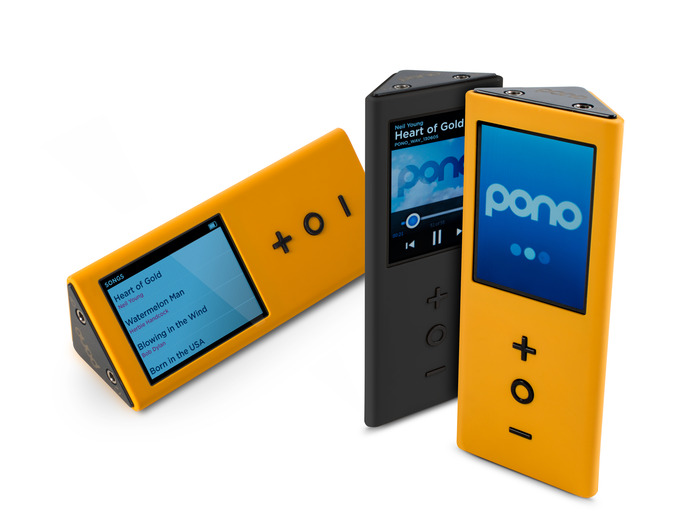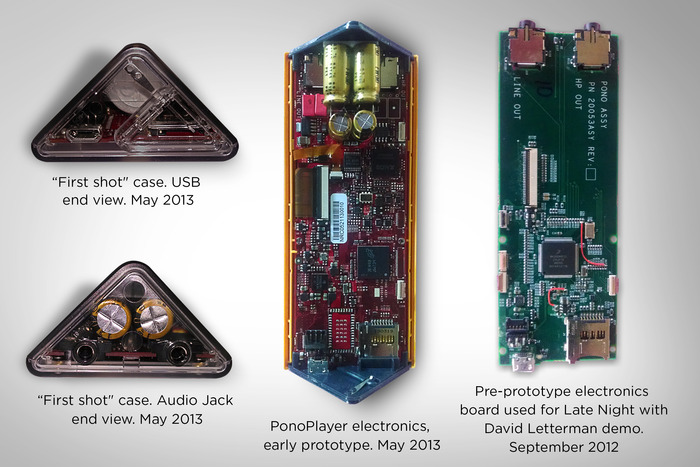PonoMusic - digital music ecosystem
On March 11, 2014, the Kickstarter campaign was launched by the PonoMusic team and the famous musician Neil Young - Pono Music . The 11-minute video is a little filled with technical details of the project and is more replete with impressions from listening to extremely famous musical performers: Sting, Jack White, Tom Petty, Mumford and Sons, Red Hot Chili Peppers, Foo Fighters and many others. The campaign has already collected the required $ 800k and has already exceeded $ 1.1kk in less than a day.

Actually, a little about the technical essence and what the project. He has 2 key points - this is the PonoPlayer audio player and the website www.PonoMusic.com . The goal is to bring high-quality digital audio to a new level, both in terms of accessibility and in terms of a tool with which you can enjoy it.
PonoPlayer will be able to play the following formats:
Options:
Memory capacity: 64GB of internal memory with the ability to add additional 64GB
Weight: 128g
Dimensions: 5x2x1 inches
Battery: Li-ion for 8h work
')

Unfortunately, I didn’t find any information about the features of the Digital-to-analog converter inside and the question of whether the device will reproduce the usual 44.1k / 16 FLAC with the same quality as the well-known audio players remains open.
www.PonoMusic.com will be the place where, in fact, it will be possible to purchase the highest quality audio. This is not just a cloud, files can be downloaded. The estimated cost of one album is $ 15-25.
The campaign offers many types of cash aid (pledge), for some ($ 400) you can get PonoPlayer limited editions with the signature of famous musicians (already partially disassembled). The usual version of PonoPlayer can be obtained for $ 300. The promised date is October 2014.
Free translation of the PonoPlayer technology? :
PS In the comments it is proposed to arrange a controversy about 44.1kHz / 16bit vs 96kHz / 24bit, the limits of human hearing, etc.

Actually, a little about the technical essence and what the project. He has 2 key points - this is the PonoPlayer audio player and the website www.PonoMusic.com . The goal is to bring high-quality digital audio to a new level, both in terms of accessibility and in terms of a tool with which you can enjoy it.
PonoPlayer will be able to play the following formats:
- CD lossless quality recordings: 1411 kbps (44.1 kHz / 16 bit) FLAC files
- High-resolution recordings: 2304 kbps (48 kHz / 24 bit) FLAC files
- Higher-resolution recordings: 4608 kbps (96 kHz / 24 bit) FLAC files
- Ultra-high resolution recordings: 9216 kbps (192 kHz / 24 bit) FLAC files
Options:
Memory capacity: 64GB of internal memory with the ability to add additional 64GB
Weight: 128g
Dimensions: 5x2x1 inches
Battery: Li-ion for 8h work
')

Unfortunately, I didn’t find any information about the features of the Digital-to-analog converter inside and the question of whether the device will reproduce the usual 44.1k / 16 FLAC with the same quality as the well-known audio players remains open.
www.PonoMusic.com will be the place where, in fact, it will be possible to purchase the highest quality audio. This is not just a cloud, files can be downloaded. The estimated cost of one album is $ 15-25.
The campaign offers many types of cash aid (pledge), for some ($ 400) you can get PonoPlayer limited editions with the signature of famous musicians (already partially disassembled). The usual version of PonoPlayer can be obtained for $ 300. The promised date is October 2014.
Free translation of the PonoPlayer technology? :
PonoPlayer was designed with an uncompromising approach to sound quality. We collaborated with a team of engineers from Ayre ( www.ayre.com ) to incorporate some of their world-class audio technologies into our PonoPlayer. The Ayre team describes its contribution to the development of PonoPlayer as follows:
- The digital filter used in PonoPlayer has a minimal phase and no non-natural (digital) lead. All sounds produced (and the music itself) always have reverb and / or echo after the main sound. There is no such sound in nature that has an echo or reverb to a sound that ordinary linear-phase digital filters make. This is one of the reasons why digital sound has a reputation for unnatural and coarse sound.
- All schemes are feedback feedback schemes. The feedback (feedback) can correct errors only after they happen, which means that it cannot correct them all. Using the patented ultra-linear circuit with a wide bandwidth and low output impedance, there is no longer any need for artificially sound feedback.
- The used DAC chip (Digital-to-Analog Converter) is recognized in the audio and engineering community as one of the best-performing chips available today.
- The output buffer used for headphones is completely discrete, which allows you to optimize all individual parameters and settings for perfect sound quality. The full output impedance is very low, so PonoPlayer provides a perfectly flat frequency response and a wide range of volume when using almost any headphone.
Original (eng.)
The PonoPlayer was designed with a “no compromises” approach to sound quality. We’re partnered with our engineering team at PonoPlayer. The PonoPlayer design as follows:
- The digital filter used in the PonoPlayer has a minimal phase of pre-ringing. All sounds made (including music) always have reflections and / or echoes after the initial sound. It is not a sound in nature. This is one of the reasons for sounding “unnatural” and harsh.
- All circuitry is zero-feedback. It can be correct for you. By using proprietary ultra-linear circuitry, there is no need for unnatural sounding feedback.
- The DAC (Digital-to-Analog Converter) is available today.
- It has been shown that it has been possible to fully optimize for the absolute finest sound quality. It’s a great deal of convenience and it’s possible to use headphones.
PS In the comments it is proposed to arrange a controversy about 44.1kHz / 16bit vs 96kHz / 24bit, the limits of human hearing, etc.
Source: https://habr.com/ru/post/215525/
All Articles